
11
3 Installation
This chapter describes how to install RX-C4. To function correctly, an RX-C4 needs at least the
following:
Power supply.
Receiving antenna.
Connection to a PC using the serial port and/or a local area network.
The following paragraphs will discuss these connections as well as grounding and lightning
protection considerations.
3.1 Power supply
The AC version of the receiver must be fed from a AC power source with a voltage between
100 and 240 V. Please refer to
paragraph 6
for the exact voltage and power requirements.
The customer should provide for a cord set terminated with connector type C13 according to
IEC 60320-1 and a mains plug in accordance with national standards. The RX-C4 is a class I
appliance and requires an earthed socket for connection to protective-earth.
The DC version of the receiver must be fed with a nominal voltage of 12VDC. Please refer to
paragraph 6
for the exact voltage and power requirements. The supplied power lead has 3 leads.
The blue and brown leads connect to the DC power supply. The yellow/green lead must be
connected to (safety) ground. See
paragraph 2.1
3.2 Receiving antenna
General HF link considerations
Directional Waverider buoys use a low power HF transmitter. The transmitting antenna is a
vertically polarized quarter wavelength whip. The receiving end of the link should receive as
much signal from the buoy transmitter and as little noise and interference as possible. To
achieve this the receiving antenna and -station should preferably be located at or near the coast,
see
Appendix A
and
Appendix D
for more information.
Receiving antenna location and height
The transmitter antenna is vertically polarised, therefore the receiving antenna must also be
mounted vertically. For the assembly of the antenna and adjustment of its length to the transmit
frequency see
Appendix D.
Over sea the field strength does not vary significantly with the height of the receiving antenna
up to 100 m. If the receiving antenna can be located within a few tens of meters of the sea, its
height is not important.
Over land the field strength is attenuated by RF losses in the ground. For this reason it is
recommended that the antenna should be placed within a few tens of meters of the sea if
possible. If the distance from the sea is greater, the ground losses can (partially) be compensated
for by mounting the antenna at an height up to 20-30 meters. Generally, more than 20 -30m
above sea level will not improve the reception quality.
If possible mount the antenna in such a way that is has a free “sight” in the direction of the
buoy. Large structures such as embankments, ships and buildings in the direct optical path to the
buoy will attenuate the received signal.
Содержание RX-C4
Страница 4: ...4 ...
Страница 6: ...6 ...
Страница 8: ...8 ...
Страница 14: ...14 ...
Страница 26: ...26 ...
Страница 28: ...28 ...
Страница 40: ...40 Appendix D Receiving antennas Standard groundplane antenna Figure D1 Standard groundplane antenna ...
Страница 42: ...42 Figure D3 Directional quarter wave antenna ...












































